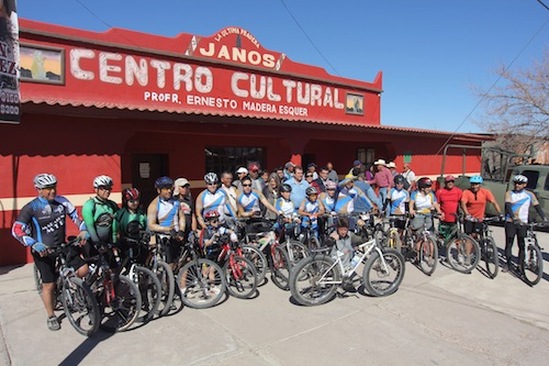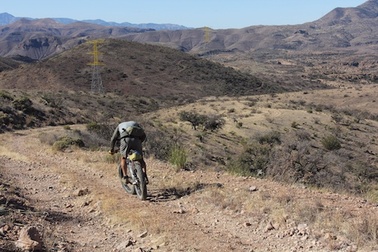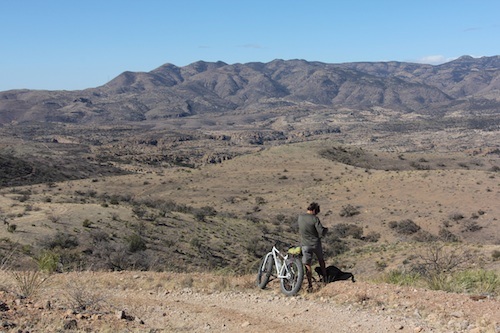John Davis Continues his TrekWest Through Mexico to Raise Awareness for Wildlife Corridors
From eastern Sonora over Sierra Madre crest into western Chihuahua
As the truck ground down the sinuous mountain road, and its headlights came into sight, Cindy Tolle barked an order: make bat wings around the fire! When Cindy Tolle gives an order, you quickly comply, for she is not one to worry needlessly. Cindy is a climbing guide with scores of first ascents to her name, plus dozens of years of traveling and living in remote parts of Mexico, so we dared not gainsay her command but quickly stood in a semi-circle around the side of the fire nearest the road, hoping the unexpected visitors were not drug-runners and would not see our humble campfire. Three old trucks and as many nervous hours later, we decided any passers-by were probably as afraid of us as we of them, not narcos out to eliminate anyone in their way, and we retired quietly to our tents, under bright stars by the Arroyo Cueva, on the west side of the Sierra Madre.
I’d come to this point by four-wheel drive car with trip leader Cindy Tolle, founder of the Tutuaca Mountain School (tutuaca.org, which is raising funds to acquire and restore lands in Tutuaca watershed); engineer David Nelson, who kindly provided the safety vehicle; and filmmaker Ed George, who has fit into the trek so well, he is now part of the team (and will continue joining us periodically throughout this trek, if we can procure funds for a full documentary).
Leading or following within a few miles, however, would be the safety car, with Cindy, Ed, Dave, and most of my gear. I’d agreed even before reaching Mexico that safety was more important than purity. In truth, campfire frights notwithstanding, we never felt any great danger, had no unpleasant encounters, and generally agreed that travel in the Mexican back-country is becoming relatively safe again; but we were taking no chances. Also, we realized once daylight arrived that a reason for the unexpected vehicles that first night may have been that we’d camped near a side track to a trout farm – an ecologically damaging but entirely legal economic activity, which unfortunately the federal government is subsidizing in some places.
On this main road east-west across the Sierra Madre Occidental, once east of the trout farm detour, we were passed by one truck in each direction during 70 miles of bone-pounding, relentlessly sloping road. My weakest link to the bicycle, my rear-end, got so sore I had to stand as much as terrain allowed, and my wrists ached (both having been broken years ago in reckless youthful pursuits, and now periodically reminding me of my senescence). The scenery more than countered the discomfort, though, as incense cedars and sycamores along the creek yielded to oak savanna at around 5,000 feet and then to soughing pines (Apache, Chihuahuan, and the endemic Lumholtz, among the many Pinus species) at about 6,000 feet, the trees often affording me welcome shade in the intense sun. Mexico, by the way, leads the world in diversity of oak and pine species, with something like 170 of the former and 45 of the latter.
Cindy said that sadly, much of the loss of wildlife is probably attributable to poverty; people in this region struggle economically, face hunger, and therefore may shoot anything they can for food. (Soon after seeing the living flock of turkeys, we came upon the feathers of one apparently shot.) I suspected, and others agreed, that overgrazing by cattle and occasional poisonings of wildlife by ranchers are also culprits in the loss of wild treasures of the Mexican mountains. Given real protection, the wildlife and land of the Sierra Madre could recover almost fully, and again provide safe homes for lobo, jaguar, puma, eagles, trout, and other charismatic species. Without more protection, though, the Sierra Madre may exemplify what conservation prophet Lois Crisler warned of decades ago: wildlands without wildlife are just scenery.
Nor are the threats to the Sierra Madre merely the everyday overuse sort. The rough and sparsely travelled mountain road I was riding has been proposed for widening and paving, which would terribly diminish the wildness of this remote region. From one high point early on the eastward ride, we looked down far below to the open wound of mineral prospecting; if the speculators find gold, land and water and wildlife will suffer for decades to come.
Most of the pine forest has been logged at some time or another, but much of the oak woodland may essentially be old growth. Moreover, the plant communities here are relatively free of exotic species, perhaps because, ironically, poverty has meant that few ranchers can afford to import foreign forage species. Forest ecologist Citlali Cortes-Montano, whom we met a few days later at Janos, has done research on old-growth forest remnants at Mesa des Guacamayas (north of where we were crossing the mountains) and elsewhere, affirming that old pine forests are essential habitat for thick-billed parrots and other native species.
I met my friends in the car twice along the fabled Gavilan River, as we worked our way across the Sierra Madre. The great conservationist Aldo Leopold gave this remote mountain stream a lasting place in literature when he described the watershed’s pristine oak savannas and pine forests in an essay in his classic book A Sand County Almanac. This is where Leopold had his famous epiphany about the importance of top predators, as he watched the green fire dying in the eyes of a wolf he’d just shot (a story that my mentor Dave Foreman has told to countless audiences and that still brings tears to my eyes). Unfortunately, decades after Leopold compared the wild conditions along the Gavilan favorably with otherwise comparable watersheds in the American West, the standard insults – overgrazing by livestock, overkill of predators and other wildlife, fragmentation by roads – have taken their toll.
A few days after crossing the Sierra Madre, I was fortunate to meet the grandson of the man who guided Leopold into the Gavilan backcountry. Historian John Hatch told me that his grandfather and Aldo Leopold found natural, original conditions because the late persistence of the Apache people here had kept out European invaders. Once the Apache were driven out, the domestication and destruction began, and the toll includes, according to Hatch (who is also a backcountry guide), an amazing diversity of trout species and subspecies, some of which survive in still-remote stream reaches. Hatch assured me that wildlife in this part of the Sierra Madre is more abundant than my brief glimpse would suggest, though diminished from yester-year, and more severely diminished to the south.
The Gavilan and its mother range are beautiful beyond description, we travelers agreed, but many of the eyes who should be seeing this beauty and feet who should be traversing it – including those of the great runner Lobo — have been lost to human poverty and short-sightedness. If only Leopold’s great epiphany could somehow be transmitted across generations and cultures to reawaken in American and Mexican peoples a compassion for all life and a desire to restore lost treasures, like lobo, jaguar, grizzly bear, parrot, and trout.
TrekWest Action: Please go to tutuaca.org, and help provide funds to acquire and restore lands in Tutuaca watershed.
For the Wild,
John



